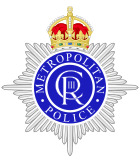
Back Metropolitan Police Breton Metropolitan Police Service Catalan Metropolitní policie Czech Heddlu Metropolitan Welsh Metropolitan Police Service Danish Metropolitan Police Service German Μητροπολιτική Αστυνομική Υπηρεσία Greek Londona Metropola Polica Servo Esperanto Policía Metropolitana de Londres Spanish Metropolitar Polizia Zerbitzua Basque
| Metropolitan Police Service | |
|---|---|
Logo | |
 Badge under the reign of Charles III since July 2024 | |
 Flag under the reign of Charles III since July 2024 | |
| Common name | The Met[1] |
| Abbreviation | MPS[2] |
| Agency overview | |
| Formed | 29 September 1829[3] |
| Preceding agencies | |
| Employees | 43,571 in total[6] 32,493 police officers[6] 9,816 police staff[6] 1,262 PCSOs[6] |
| Volunteers | 1,858 special constables 1,500 police support volunteers 3,658 volunteer police cadets |
| Annual budget | £4.43 billion[7] |
| Jurisdictional structure | |
| Operations jurisdiction | Greater London (excluding the City of London) |
 | |
| Map of the Metropolitan Police District | |
| Size | 1,578 km2 (609 sq mi) |
| Population | 8.95 million (2019/20)[8] |
| Legal jurisdiction | England and Wales (throughout the whole of the United Kingdom, including Scotland and Northern Ireland, under certain limited circumstances) |
| Primary governing body | Mayor's Office for Policing and Crime |
| Secondary governing body | Home Office |
| Constituting instruments | |
| General nature | |
| Operational structure | |
| Overseen by | |
| Headquarters | New Scotland Yard, Westminster, London, England |
| Police officers | 32,493 full time 1,858 special constables |
| PCSOs | 1,262 |
| Deputy Mayor for Policing and Crime responsible | |
| Agency executives | |
| Website | |
| www | |
The Metropolitan Police Service (MPS), formerly and still commonly known as the Metropolitan Police, or simply the Met, is the territorial police force responsible for law enforcement and crime prevention within Greater London. In addition, it is responsible for specialised tasks throughout the United Kingdom, such as dealing with counter-terrorism throughout the UK, and the protection of certain individuals, including the monarch, royal family, governmental officials,[10] and other designated figures. It is also referred to as an eponym as Scotland Yard or the Yard, after the location of its original headquarters in Great Scotland Yard, Whitehall, in the 19th century.[11] The Met is presently headquartered at New Scotland Yard, on the Victoria Embankment.[12]
The main geographical area covered by the Met, the Metropolitan Police District, consists of the 32 London boroughs,[13] and excludes the square mile of the City of London – a largely non-residential and financial district, overseen by the City of London Police. As the force responsible for the majority of UK's capital, the Met has significant responsibilities and unique challenges, such as protecting 164 foreign embassies and High Commissions,[14] policing London City and Heathrow airports, protecting the Palace of Westminster, and managing a higher volume of protests and events than any other British police force, with 3,500 such events in 2016.[14]
The force, by officer numbers, ranks as the largest police force within the United Kingdom.[15] Excluding its national roles, the Met oversees the eighth-smallest primary geographic area (police area) compared to other territorial police forces in the UK.
The force operates under the leadership of the Commissioner of Police of the Metropolis, directly accountable to the Mayor of London, through the Mayor's Office for Policing and Crime and the Home Office. The post of commissioner was first held jointly by Sir Charles Rowan and Sir Richard Mayne, with Sir Mark Rowley currently holding the position since July 2022.[16]
- ^ "Metropolitan Police Service – Homepage". Metropolitan Police. 2 April 2009. Archived from the original on 8 July 2017. Retrieved 6 May 2009.
- ^ "Contacts: MPS". MPA. Archived from the original on 14 January 2012. Retrieved 2 June 2010.
- ^ "Metropolitan Police Service – History of the Metropolitan Police Service". Metropolitan Police. Archived from the original on 26 April 2009. Retrieved 6 May 2009.
- ^ "The Bow street runners – Victorian Policeman by Simon Dell OBE QCB – Devon & Cornwall Constabulary". Devon-cornwall.police.uk. Archived from the original on 13 October 2003. Retrieved 6 May 2009.
- ^ "Policing the Port of London – Crime and punishment". Port Cities. Archived from the original on 5 October 2012. Retrieved 6 May 2009.
- ^ a b c d "The structure | the Met". www.met.police.uk. Archived from the original on 25 June 2017. Retrieved 23 June 2020.
- ^ "London Police Budget 2023". Archived from the original on 18 September 2023. Retrieved 14 September 2023.
- ^ "Metropolitan Police Service". His Majesty's Inspectorate of Constabulary and Fire & Rescue Services. Archived from the original on 9 May 2021. Retrieved 26 May 2021.
- ^ "Dame Lynne Owens announced as Met Deputy Commissioner". Metropolitan Police. 20 February 2023. Archived from the original on 29 March 2023. Retrieved 21 February 2023.
- ^ "MPA – Metropolitan Police dedicated to protecting the United Kingdom from terrorism". whitehallpages.net. Archived from the original on 24 July 2011. Retrieved 22 July 2011.
- ^ Douglas Browne (1956) The Rise of Scotland Yard: A History of the Metropolitan Police
- ^ "New Met HQ officially 'Topped Out' by Commissioner and Deputy Mayor". December 2015. Archived from the original on 9 July 2021. Retrieved 17 March 2021.
- ^ "The Met's area of jurisdiction | The Met". www.met.police.uk. Archived from the original on 23 October 2020. Retrieved 6 March 2019.
- ^ a b "MPS Business Plan 2017–18" (PDF). Archived (PDF) from the original on 23 March 2019. Retrieved 6 October 2018.
- ^ "Metropolitan Police Authority". MPA. Archived from the original on 19 July 2006. Retrieved 20 July 2006.
- ^ "Mark Rowley appointed new commissioner of Met police". TheGuardian.com. 8 July 2022. Archived from the original on 25 March 2023. Retrieved 20 December 2023.